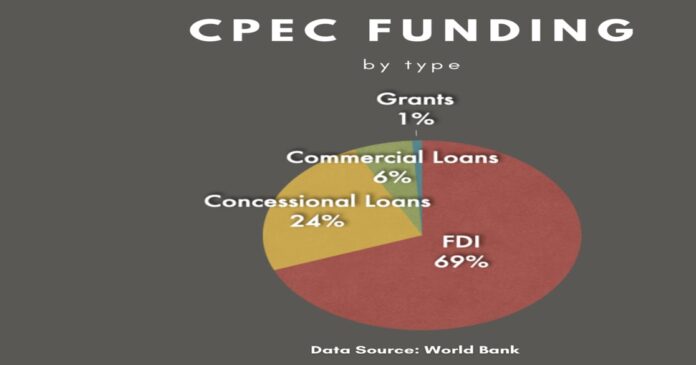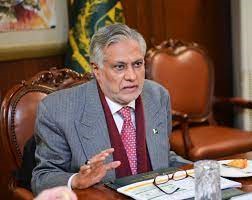BEIJING: Pakistan under the burden of Chinese debt is not a true statement as considering all the funds that China has provided to Pakistan, including the safe deposits, it amounts to approximately 20 percent. “And as I mentioned, most money came as a swap.
They are reserves in Pakistani banks to avoid default. The rest are concessional loans trying to help us create economic opportunities for more financial resources and revenue, which will help to avert our debt crisis, says report carried by Xinhua.
Our real problem is the foreign debt from the Western financial institutions. Pakistan cannot pay them back because they are high-interest loans. Some of them, like private debt, are even higher,” said Ramay. “Pakistan also sold bonds in the Western market at a higher rate. Those all are causing real problems for Pakistan.
Take the textile industry. In its story, AP said, “In Pakistan, millions of textile workers have been laid off because the country has too much foreign debt and can’t afford to keep the electricity on and machines running.”
For Shahid Sattar, secretary general of the All Pakistan Textile Mills Association, the sector was hit by a “perfect storm” of a liquidity shortage caused by the significant change in rupee-dollar parity, delays in sales tax refunds and the cotton crop failure in Pakistan.
“But to blame it on China is completely absurd. China has been working with Pakistan to resolve our economic issues sustainably,” Shahid said.
Countries defaulting, inflation soaring, people losing jobs and their families facing starvation … This is the bleak picture painted by Western media of the world’s poorest countries falling into a “debt trap.”
China, again, became an easy target to blame. A recent Associated Press (AP) story, titled “China’s loans pushing world’s poorest countries to the brink of collapse,” accused China of setting up the so-called “debt trap” and labeled it as the “world’s biggest and most unforgiving government lender.” But does this allegation hold water?
On-site investigations conducted by Xinhua on several countries, including Pakistan, Kenya, Zambia and Sri Lanka, present a contrasting perspective to the AP report, shedding new light on their debt impasse.
According to the National Treasury of Kenya, Kenya’s external debt stock stood at 36.66 billion U.S. dollars at the end of March 2023. The debt is owed to multilateral lenders (46.3 percent) and bilateral sources (24.7 percent), among others. As of March 2023, Kenya owed Chinese entities, including Chinese banks and companies, 6.31 billion dollars, but the largest chunk of Kenya’s debt — 17 billion dollars — is owed to the International Monetary Fund (IMF) and the World Bank (WB).
Citing World Bank IDS data, a Briefing Paper titled “Integrating China into Multilateral Debt Relief: Progress and Problems in the G20 DSSI,” released by the Johns Hopkins University in April, showed that “China (Chinese entities) only holds 21 percent of Kenya’s public external debt, with private creditors holding another 24 percent and multilateral institutions 45 percent.”
Data exclusively given to Xinhua by the Economic Affairs Division (EAD) of Pakistan showed that as of April 2023, Pakistan’s total external debt was 125.702 billion dollars, while the loan from Chinese entities was 20.375 billion dollars, and some 4 billion dollars more from the Chinese side as safe deposits, making Chinese entities’ debt in Pakistan only 16.2 percent of its total (without adding the safe deposits).
“This (AP’s story) is not the first story. It is a series of stories (to defame China),” Shakeel Ahmad Ramay, CEO of the Asian Institute of Eco-civilization Research and Development in Pakistan, told Xinhua.
According to WB statistics, nearly three-quarters of Africa’s total external debt is held by multilateral financial institutions and commercial creditors, making them the largest creditors in Africa, said Wang Zhan, member of the International Finance and Economics Research Expert Studio of China’s Ministry of Finance.
In the article, AP claimed, “Behind the scenes is China’s reluctance to forgive debt,” portraying the country as an unforgiving lender.
Responding to the AP story, Song Wei, professor at the School of International Relations and Diplomacy, Beijing Foreign Studies University, said that China’s contribution to debt relief exemplifies the international obligations expected of a responsible major country.
In the 46 countries that participated in the DSSI, Chinese creditors accounted for 30 percent of all claims, and contributed 63 percent of debt service suspensions.”
Song said she believes China is a genuine partner for developing countries needing capital to support nation-building projects.
“Moreover, debt suspension and relief should be a collective effort: multilateral, bilateral, commercial. China’s proposal of shared responsibility in debt relief is fair and reasonable since all parties involved are creditors. It is unjust for only one side to bear the burden of debt reduction while others are exempted from their responsibilities,” Song said.
Referring to data from the WB, professor Ding Yibing, dean of School of Economics, Jilin University, highlighted that since 2016, China, as a bilateral creditor, has been responsible for roughly 16 percent of global debt relief, surpassing the United States and the WB, adding that China’s debt reduction has already doubled the average reduction scale of the G7 countries.
“Among G20 members, China has provided the largest debt relief overall,” said Ding. “However, China’s proportion of debt to Africa as a whole is not high. Multilateral financial institutions and commercial creditors hold the highest share of debt. Even without China’s debt, these countries still face high debt pressure.”
In recent years, various factors such as the U.S. Federal Reserve’s interest rate hikes, global commodity price cycles, the economic structures of certain developing nations, the COVID-19 pandemic and the Ukraine crisis have led to a liquidity shortage. This has severely constrained the repayment capacity of some developing countries, leading to sovereign debt crises.
Therefore, placing blame on China for the debt crisis is unjust and misleading. A detailed case study of Pakistan can provide a clearer understanding of the situation.
The AP story said a dozen countries “most indebted to China,” including Pakistan, “found paying back that debt is consuming an ever-greater amount of the tax revenue needed to keep schools open, provide electricity and pay for food and fuel.”
With the dollar’s dominance, the United States implemented rounds of quantitative easing and lowered interest rates to near zero, causing a significant inflow of low-interest dollars into Africa and emerging markets. However, it later increased interest rates aggressively, leading to a stronger dollar and capital outflows. Consequently, this resulted in a liquidity shortage, disrupted funding chains, currency depreciation, and a surge in sovereign debt, said Ye Jianru, associate professor at Guangdong University of Foreign Studies.
For Ye, also researcher at the Institute of African Studies of Guangdong University of Foreign Studies, an unfair global financial system led by the United States is the root cause of Africa’s debt problem.























